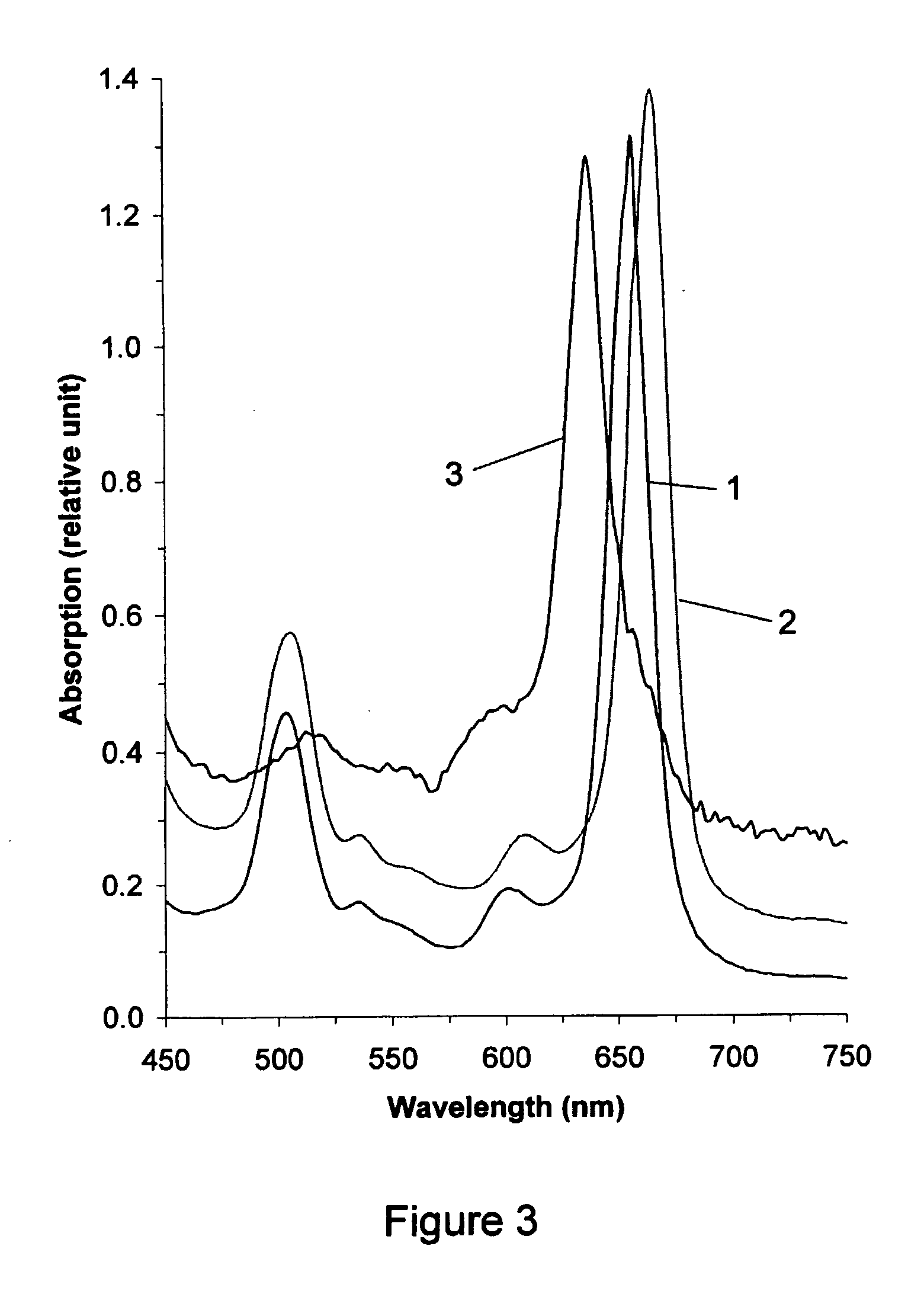Photosensitizers and MRI Enhancers
a technology of enhancers and photosensitive materials, applied in the field of photosensitive materials and enhancers, can solve the problems of difficult preparation and purification, low selectivity of tumour tissues, and accumulation of slowly, and achieve the effect of accurately identifying malignant tissues
- Summary
- Abstract
- Description
- Claims
- Application Information
AI Technical Summary
Benefits of technology
Problems solved by technology
Method used
Image
Examples
example 1
[0154]Ammonia was added to water until the pH of the solution was not less than 9. Then chlorine-e6 (1.0 g) was dissolved in the aqueous solution. An equimolar quantity of zinc acetate (0.22 g) was added and the reaction mixture was stirred for 15 minutes at about 20° C. to achieve the complex-formation reaction. The progress and completion of the reaction was monitored with the help of a spectrophotometer. On completion of the complex-formation reaction, serum humane albumin (SHA) (71 g) was added to the reaction mixture as an immobilizer. On completion of the immobilization reaction, which was monitored with a spectrophotometer, the product of the reaction, Zn-chlorine-e6 complex immobilized on SHA, was purified by dialysis.
[0155]FIG. 1 shows the long-wave region of the visible absorption spectra of (1) the starting material chlorine-e6 (λmax=656 nm), (2) Zn-chlorine-e6 complex (λmax=632 nm), and (3) Zn-chlorine-e6 complex immobilized on SHA (λmax=636 nm), all in water.
[0156]As ca...
example 2
[0158]The synthesis of immobilized Zn-chlorine-e6 was carried out as described in Example 1, except that as immobilizer polyvinylpyrrolidone (PVP) (62 g) was used instead of SHA.
[0159]As can be seen in FIG. 4, the spectral picture of the visible absorption spectra of (1) the starting material chlorine-e6 (λmax=656 nm), (2) Zn-chlorine-e6 complex (λmax=632 nm), and (3) Zn-chlorine-e6 complex immobilized on PVP (λmax=638 nm) are practically identical to the ones depicted in FIG. 1. One observes a significant 24 nm short-wave shift of the long-wave peak upon metal complex formation and a small 6 nm long-wave shift upon immobilization on polymer PVP. The medium intensity peak of chlorine-e6 at λmax=502 nm practically disappears, when forming the Zn-chlorine-e6 complex. All of these changes prove the completeness of the reactions and the purity and homogeneity of the products obtained.
example 3
[0160]Ammonia was added to water until the pH of the solution was not less than 9. Then chlorine-e6 (1.0 g) was dissolved in the aqueous solution. An equimolar quantity of SHA (71 g) was added and the reaction mixture was stirred for 17 minutes at about 20° C. to immobilize chlorine-e6 on SHA. Then an equimolar quantity of zinc acetate (0.22 g) was added and the reaction mixture was stirred at room temperature to complex Zn into the chlorine-e6, which was monitored with a spectrophotometer. The product of the reaction, Zn-chlorine-e6 complex immobilized on SHA, was purified by dialysis.
[0161]FIG. 3 shows the long-wave region of the visible absorption spectra of (1) the starting material chlorine-e6 (λmax=656 nm), (2) chlorine-e6 immobilized on SHA (λmax=662 nm), and (3) Zn-chlorine-e6 complex immobilized on SHA (λmax=636 nm). Unlike the first method of synthesis (see Example 1), when forming chlorine-e6 immobilized on protein, first a 6 nm long-wave shift of the absorption peak occu...
PUM
| Property | Measurement | Unit |
|---|---|---|
| wavelength | aaaaa | aaaaa |
| wavelength | aaaaa | aaaaa |
| wavelength | aaaaa | aaaaa |
Abstract
Description
Claims
Application Information
 Login to View More
Login to View More - R&D
- Intellectual Property
- Life Sciences
- Materials
- Tech Scout
- Unparalleled Data Quality
- Higher Quality Content
- 60% Fewer Hallucinations
Browse by: Latest US Patents, China's latest patents, Technical Efficacy Thesaurus, Application Domain, Technology Topic, Popular Technical Reports.
© 2025 PatSnap. All rights reserved.Legal|Privacy policy|Modern Slavery Act Transparency Statement|Sitemap|About US| Contact US: help@patsnap.com



